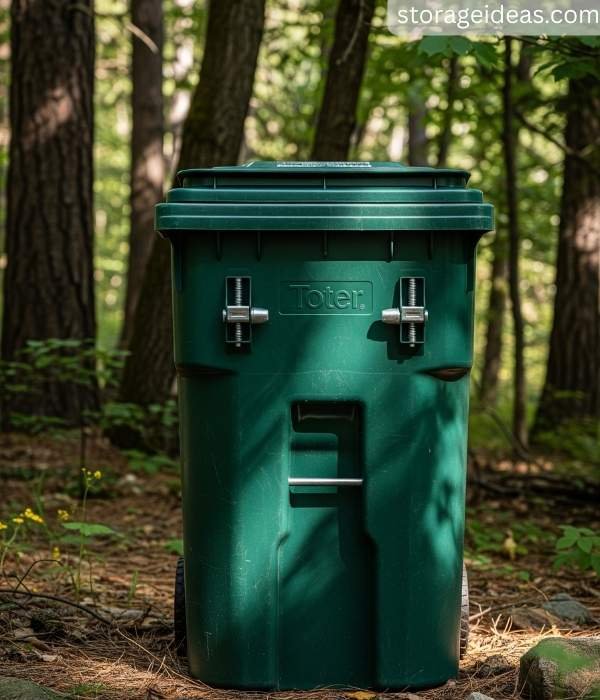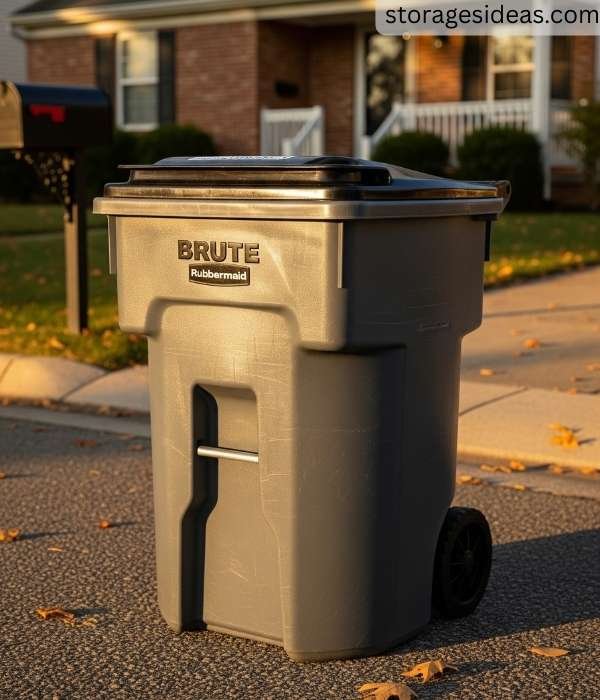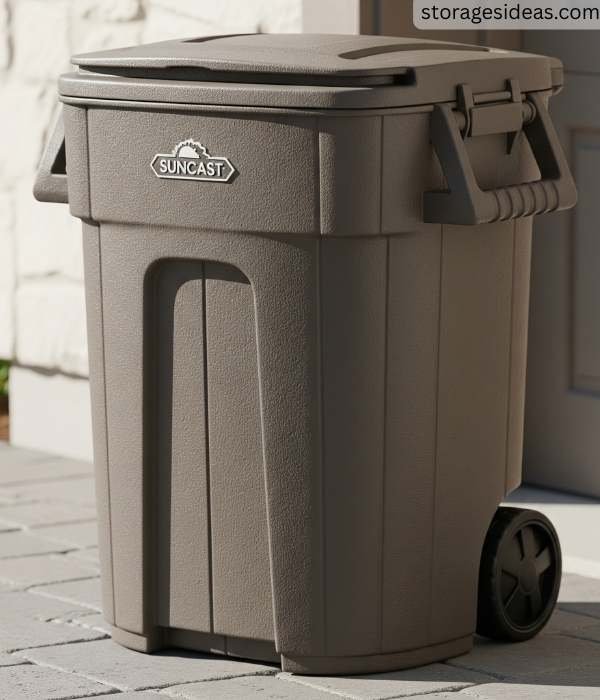I’ll be honest: I’ve had my fair share of battles with raccoons, stray dogs, and even neighborhood cats tipping over my garbage. There’s nothing quite like waking up to find your trash scattered all over the driveway. That’s when I realized the importance of investing in a proper outdoor trash can to keep animals out. Over the years, I’ve researched, tested, and refined my setup, and I want to share everything I’ve learned with you.
Before diving in, here’s what you’ll discover in this guide:
- Why choosing the right outdoor trash can is crucial.
- Key features that make a bin animal-proof.
- Types of outdoor bins and which one might suit your home.
- Placement and maintenance tips to keep animals at bay.
- Top recommended products I personally trust.
- Common mistakes to avoid.
- Answers to frequently asked questions about animal-proof outdoor bins.
By the end of this article, you’ll feel confident selecting a bin that not only keeps animals out but also makes your outdoor space cleaner, safer, and more organized.
In This Guide, I’ll Cover
ToggleWhy a Proper Outdoor Trash Can Matters
When I first moved into my house, I thought any heavy-duty bin would suffice. I was wrong. Raccoons figured out how to lift the lid, dogs dug under the sides, and the neighborhood cats… well, let’s just say they treated my yard like a litter box.
I quickly learned that the right trash can is more than just a container—it’s a defense mechanism. It protects your home, prevents unpleasant smells, and keeps your garbage where it belongs.
A good secure bin also help reduce health hazards. Animals spreading trash can carry bacteria, parasites, and even diseases. From my personal experience, a secure bin significantly cuts down on insect infestations and stray animal visits. Beyond hygiene, having a reliable bin contributes to neighborhood cleanliness—my neighbors even complimented my tidy driveway once I upgraded my system.
Key Features to Look For
Choosing the right bin isn’t as simple as grabbing the first plastic container you see. Here’s what I consider essential:
- Durable Material
Plastic bins often crack, and metal bins can rust. My go-to is high-density polyethylene (HDPE) for its toughness and weather resistance. Steel bins are also excellent, especially if they have a powder-coated finish to prevent rust. - Secure Lids
I’ve learned that a loose lid is an open invitation. Pedal-operated lids, locking lids, or click-fit lids prevent animals from accessing the trash. Some bins even have double-lid systems, which provide extra protection. - Size and Capacity
Too small, and you’ll have overflow; too big, and it’s cumbersome. My experience shows that a 32- to 50-gallon bin strikes the perfect balance. - Weather Resistance
Rain, snow, and sunlight can warp bins over time. I look for UV-resistant, waterproof, and corrosion-proof materials. - Animal-Proof Design
Look for bins specifically labeled as “bear-proof” or “wildlife-resistant.” Features such as reinforced hinges, locking lids, and weighted bases make a huge difference. - Ease of Use
While keeping animals out is the priority, you also want convenience. I prefer bins that are easy for humans to open and empty, with smooth wheels or handles.
Types of Outdoor Trash Cans to Keep Animals Out
Over the years, I’ve explored several types of bins. Here’s what I learned about each:
1. Pedal Bins
Pedal bins are convenient because you can open the lid with your foot. Many outdoor versions are now heavy-duty and weather-resistant. I love these because I don’t have to touch the lid with my hands, and animals can’t figure out the pedal mechanism.
2. Bear-Proof Trash Cans
Bear-proof cans have reinforced lids, heavy construction, and locking mechanisms that make it almost impossible for animals to open them.
3. Motion-Sensor Containers
Some bins feature motion-activated lids or alarms. When an animal approaches, the lid stays closed or an alert sounds. These are especially useful for urban areas.
4. Traditional Heavy-Duty Outdoor Bins
Even simple bins can work if they have tight-fitting lids, heavy construction, and proper placement. Small modifications like bungee straps can make a big difference.
5. Compost and Organic Waste Bins
Compost bins are specialized outdoor containers that transform food scraps and garden waste into nutrient-rich soil. These are usually sealed to prevent animals from accessing the organic material.
6. Recycling and Multi-Compartment Bins
These bins separate recyclables like paper, plastics, and glass. I like these for convenience and eco-consciousness.
Placement and Maintenance Tips
Having the right bin is one thing, but placement and upkeep are just as important. Over the years, I’ve learned several strategies:
- Place Bins on a Flat, Stable Surface – Concrete pads, patio slabs, or pavers prevent tipping.
- Avoid Climbable Surfaces – Keep bins away from fences, trees, or ledges.
- Use Shaded or Covered Areas – Protects bin material and reduces odors.
- Anchor Bins in High-Risk Areas – Chains, bungee cords, or brackets prevent tipping.
- Separate Organic Waste – A sealed compost bin reduces smell and animal interest.
- Maintain Regular Cleaning – Weekly washing with detergent keeps odors and insects away.
- Keep Lids Secure – Double-check alignment and add bungee straps if needed.
- Avoid Overflowing Bins – Compact trash and empty regularly.
- Position Away from Animal Pathways – Observe wildlife patterns for ideal placement.
- Rotate Bin Locations Occasionally – Prevents animals from memorizing positions.
- Seasonal Adjustments – Add weights in winter; rinse bins frequently in summer.
- Add Deterrents Around the Bin Area – Motion-activated sprinklers, reflective tape, or natural scent repellents help deter animals.
Common Mistakes I’ve Made (and Learned From)
- Ignoring the Lid Mechanism – Loose lids invite raccoons.
- Placing Bins Near Climbable Surfaces – Even the best bin fails if animals can jump in.
- Skipping Regular Cleaning – Odors attract animals and insects.
- Using Small Bins for Large Households – Overflow invites animals.
- Neglecting Seasonal Adjustments – Snow, ice, or heavy rain can reduce lid effectiveness.
- Ignoring Local Wildlife Behavior – Different animals require different bin features.
- Placing Bins in Direct Sunlight – Heat warps plastic and intensifies odor.
- Failing to Secure Trash Bags Properly – Thick drawstring bags prevent leaks and spills.
- Not Checking for Small Gaps or Weak Points – Inspect bins regularly for cracks or gaps.
- Assuming One Bin Solves All Problems – Multiple bins for different waste types help prevent overflow and animal interest.
Top Recommendations I Personally Trust
Over the years, I’ve tested several outdoor trash cans, and some stood out for durability, convenience, and animal-proof features. Here’s my detailed list, along with pros, cons, and personal insights:
1. Toter 32-Gallon Bear-Resistant Bin

Why I love it:
This bin is my go-to for high-wildlife areas. The reinforced lid and locking mechanism make it nearly impossible for raccoons, stray dogs, or even bears to get inside. The wheels make it easy to roll to the curb on collection day, and the high-density plastic withstands sun, rain, and snow.
Pros:
- Locking lid prevents animal access
- Durable HDPE construction
- Easy to maneuver with wheels
- Large enough for a week’s trash
Cons:
- Higher price point
- Slightly bulky for small yards
My experience:
I’ve had this bin for over three years. A persistent raccoon tried several times to pry it open, but it never succeeded. The peace of mind alone makes this bin worth every penny.
2. Rubbermaid Brute Rollout Trash Can (32-Gallon or 44-Gallon)

Why I love it:
This is a heavy-duty option that balances size, durability, and affordability. I like how the wheels make moving it simple, and the thick plastic can handle heavy loads without cracking.
Pros:
- Affordable and widely available
- Sturdy, thick plastic
- Various sizes to suit household needs
- Lockable lids (optional add-on)
Cons:
- Not fully “bear-proof” unless you add a lock
- The lid can be slightly tricky in strong winds.
My experience:
I used this bin for a couple of years before switching to a Toter bin for extra security. Even without a built-in lock, I added a bungee strap, and it kept raccoons out reliably.
3. Simplehuman 45-Liter Pedal Bin (Outdoor Version)

Why I love it:
Pedal bins are great for hygiene and convenience. I can open the lid hands-free, and the pedal system is too complex for most animals. This outdoor version is UV-resistant and rust-proof, making it perfect for patios or small yards.
Pros:
- Hands-free pedal operation
- Compact but sufficient for small households
- Durable for outdoor use
- Sleek design
Cons:
- Smaller capacity for large families
- The pedal mechanism may wear over time if overloaded.
My experience:
I keep one of these near my side entrance. It’s perfect for quick kitchen-to-garbage disposal without attracting neighborhood animals. I love that it stays clean and odor-free with weekly maintenance.
4. Suncast 32-Gallon Resin Trash Can

Why I love it:
This bin combines lightweight construction with solid durability. I’ve found that it’s surprisingly resistant to animal interference, especially when paired with a weighted lid or latch. It also resists fading in the sun.
Pros:
- Lightweight and easy to move
- Weather-resistant resin
- Affordable and practical
- Fits under porch or patio cover
Cons:
- Requires added weight or latch for high-animal areas
- The lid may flex slightly under extreme pressure.
My experience:
I placed one of these bins in a shaded corner of my yard. By securing the lid with a simple bungee cord, I’ve had zero problems with raccoons or dogs.
5. Lifetime 32-Gallon Outdoor Trash Can with Lid Lock

Why I love it:
This is a budget-friendly option that still offers excellent animal-proof features. The lid locks securely, and the bin is durable enough to withstand heavy use. I recommend it for families who want reliability without splurging.
Pros:
- Affordable price
- Secure locking lid
- Durable plastic
- Easy to clean
Cons:
- A smaller capacity may not suit large households
- Lacks wheels, so it may be harder to move.
My experience:
I use this bin for organic waste and food scraps. Its compact size and tight lid make it perfect for keeping persistent neighborhood cats away. To know more check Ways to Keep Raccoons Out of Garbage Cans
6. Extra Tips for Choosing the Right Bin
When choosing an outdoor trash can, I also consider:
- Local wildlife habits: Areas with raccoons or bears may need reinforced bins.
- Household size and trash volume: Bigger households may need 44–50-gallon bins to avoid overflow.
- Accessibility: Make sure bins are easy for humans to use—nothing worse than struggling with a bin during collection day.
- Durability vs. weight: Heavier bins resist tipping, but extremely heavy bins may be hard to move. I balance these factors based on my yard and trash schedule.
Final Thoughts
Choosing the best outdoor trash can to keep animals out isn’t just about buying a container—it’s about design, material, placement, and maintenance. From pedal bins to bear-proof containers, there’s a solution for every home, yard, and budget.
Investing in a high-quality bin is well worth the peace of mind. No more raccoons tearing through trash or stray dogs creating chaos. A secure bin creates a cleaner, safer, and more organized outdoor space.
Once you choose the right bin and follow these tips, you’ll notice the difference immediately. Your yard will be tidier, animals will stay away, and you’ll gain a level of convenience and cleanliness that’s hard to overstate.
FAQ: Common Questions About Animal-Proof Outdoor Trash Cans
Q1: Can raccoons open any outdoor trash can? – Secure lids and heavy construction reduce risks.
Q2: Are bear-proof bins only for bears? – No, they work well for raccoons, dogs, and other animals.
Q3: How big should an outdoor bin be? – 32-50 gallons is ideal for most households.
Q4: Are pedal bins effective outdoors? – Yes, if designed for outdoor use.
Q5: Do motion-sensor bins work? – Effective in areas with persistent wildlife.
Q6: How often should I clean my bin? – Weekly cleaning is best.
Q7: Can bungee cords secure lids? – Yes, especially for bins without built-in locks.
Q8: Are compost bins worth it outdoors? – Absolutely, if sealed properly.
Q9: How do I handle animal-proof bins in winter? – Add weights or covers to keep lids closed.
Q10: Can bins attract insects even if animals can’t get inside? – Yes; sealing food waste and rinsing bins helps.
Q11: Best placement for urban vs. suburban areas? – Urban: away from alleyways and fences; Suburban: shaded, stable, away from climbable structures.
Q12: Are recycling bins at risk from animals? – Yes, clean recyclables and secure lids to prevent issues.
Q13: Can multiple bins reduce animal interference? – Yes, separate bins for organic waste, recyclables, and general trash.
Q14: Are there DIY methods to make bins more animal-proof? – Yes: bungee cords, raised platforms, weight plates, motion-activated lights, or sprinklers.

